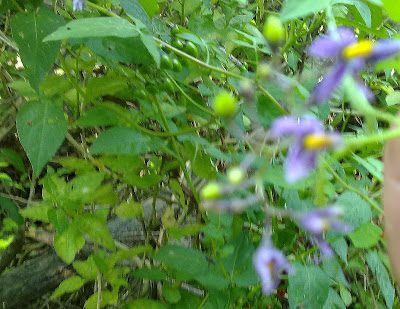Mr. Fay's Arboretum was once a known place, notable for being one of the earliest arboretums, predating Olmstead and for having flora being sighted here first in the country. Richard Sullivan Fay imported several rare species from all parts of the world (Mediterranean, Europe, Asia, Australia and other parts of the world), and filled the bare hills of the estate with exotic trees and beautiful flowers. Flora can be found around Spring Pond and in different parts of the season. People enjoyed walking the estate, admiring the vast variety of native and exotic foliage. Below is a map of the inventoried flora in the historic Fay Estate Arboretum. There are more areas to further inventory, as this is only an initial study.
To view, click on map, and again to zoom in. Right-click to download.
Flower No. 1 Cephalanthus occidentalis - Buttonbush
Button-willow and Honey-bells. A native plant found near wetlands.
Flower No. 2
Flower No. 3 Solanum Ducamara - Bitter Sweet Night Shade.
Native to Europe and Asia, as seen in the Mediterranean. Creates a purple flower first. Then turns into colorful fruit balls. (Pardon the windy day in the photo.
Flower No. 5 Philadelphus - Mock-orange.
Native species to Americas, Asia and southeast Europe. Smells like orange and Jasmine. (Thanks to Jocelyn for finding the name.)

Flower No. 6 Commelina communis - Asiatic Day Flower.
Flower No. 8
Flower No. 9 Pink Lady's Slipper 

Flower No. 10 Hatpins
Flower No. 11 Clethra alnifolia, Pepper bush
Flower No. 12 Silene Latifolia, White Campion
Native to Europe, Asia and Africa.
Flower No. 13 Wood Hyacinth
Native to Europe and the Mediterranean region.
Native flower, herb, wildflower, butterfly plant, ornamental flower bed, and Native American medicine healer. A camouflaged cricket stands on a leaf. 

"gift of God", genus of shrubs and vines in the Olive family, native to tropical climates of the "Old World" of the Mediterranean
Flower No. 16, Galanthus: Snowdrop flower
Native to Europe, stretching from the Pyrenees in the west, through France and Germany to Poland in the north, Italy, Northern Greece, Ukraine, and an old European area now in Turkey. The flower has been introduced and naturalized globally throughout the world. In most countries certain species of this flower are threatened. In blue and white colors below. 



Flower No. 17, Sakura? Cherry Blossom or Apple Blossom
Flower No. 18, Silver Dollar
Flower No. 19, Garlic Mustard Plant
Flower No. 20 Tulip
It is believed the first American tulips in the nation appeared here in the Fay Estate, among other flora. In 1847, Richard Sullivan Fay, Esq., one of Lynn's noblest men, eminent agriculturist, merchant and manufacturer, occupied the land and imported a vast variety of trees and plants from all parts of the world, and filled the empty meadows of the Fay Estate.
The Daily Item, 1952
Flower No. 21
Flower No. 22, Pussy Willow
(Undetermined origin of species.) Tree blossoms over the water of a little pond.
Flower No. 23
Flower No. 24
Flower No. 26 White Swamp Azalea
Flower No. 27 Deptford Pink (photo by Leslie C.)
Flower No. 28
Flower No. 29
Flower No. 30 Whorled Loosestrife
Flower No. 31 Milkweed (unidentified species)
Flower No. 32 St. John's Wort
Flower No. 33
Flower No. 34 American Mountain Ash
Flower No. 35 White Clover, unidentified species
Flower No. 36
Flower No. 39 Cottonwood


Flower No. 40 Apple or Cherry Blossom

Flower No. 41

Flower No. 42. Lavender Asters

Flower No. 43 Cardinal Flower
Flower No. 44 Jewel Weed
Flower No. 45 Blue Curls
Flower No. 46
Flower No. 47

Flower No. 48 Tragopogon dubius, or Centaurea
A type of Aster, native to Europe, and western Asia.

















































Flower No. 19 looks to be a Garlic Mustard Plant/Flower. According to info I found on internet it is European edible-medicinal was introduced in US in 1800s but now has become a hated invasive species because it crowds out native wildflower species.
ReplyDelete